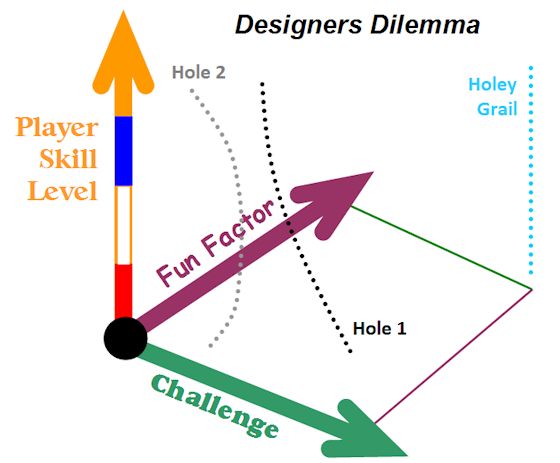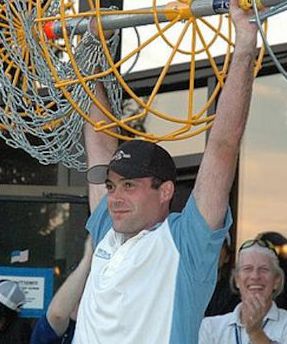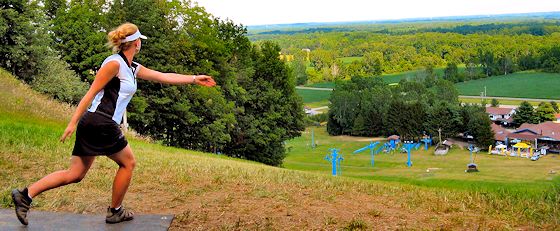Players versus Courses
Players versus Courses
These Champions & Designers Walk Tightrope

John Houck's current article in discgolfer magazine clarified that we're really talking about "risk versus reward" instead of the more common phrase "risk and reward" in course design. In a similar way, disc golf is "players versus courses" where course designers serve as proxies to try and make sure their courses challenge players.
Disc golf at its core is players against the course, not directly against each other. Player ratings are based on your score versus each course you play in competition, regardless whether you finish first or last in your division. Course designers like Harold Duvall and Stan McDaniel pictured above can be conflicted. They can use their wicked design chops to make each hole as brutally tough as possible. But most designers are active players and want you to enjoy their course design or at least feel it's fair overall. These competing goals are the narrow tightrope designers willingly must traverse.
Unfortunately, making all holes immensely Challenging and awesomely Fun is impossible and likely not even desirable to produce a well balanced course. Complicating it even further, consider that the same hole can be seen and play differently depending on a player's current skill level. Try to think of these three factors in 3D space as shown in this Designers Dilemma diagram.

Each dotted line indicates how the same hole might be seen by players at different skill levels moving from red level up to gold. The "Holey Grail" dotted blue line out to the right is a "perfect" hole that has maximum challenge and fun factor for every skill level. Holes that might get close to this ideal are probably downhill, short enough to be reached by most skill levels, have some tricky elements such as well positioned trees, and likely some OB. Even then, it's tough to tweak these holes so it's challenging enough (not fluky) for the top gold level and not too challenging for rec players.
The Hole 1 dotted line might be found on a gold level course where challenge and fun factor are average for gold level players but it gets increasingly more challenging for lower level players. The Hole 2 dotted line might be found on a layout for white level players. The challenge and fun are higher for blue and white level players because it's in their wheel house. The challenge isn't enough for gold players and may not be much fun for red level players (wrong length, non-reachable).
Players Seek Mastery
Let's go out on a pretty sturdy limb regarding human nature and how we approach challenges, in this case, tackling a course. Competitors strive in varying degrees to develop mastery in their sport and discover their competitive edges. Many are open to learning and even creating tricks, discovering legal angles, developing creative ways to do things that the rules may not have addressed (yet), and some will even bend the rules to gain an edge over competitors. In disc golf, our goal is to "defeat" the course.

Examples of disc golf advances over its 40+ year history that have been developed to either enhance or tame the competitive edges of players and disc golf courses are:
- Implementing the beveled edge disc to throw farther and advance beyond early course designs,
- Rule additions or changes such as casual relief allowances or 2 meter optional,
- Tech standards changes to cap certain dimensions on discs and targets,
- Competition rule additions such as no drinking during round or dropping out to protect rating.
- Player developed angles such as reverse stance or walk through putting outside 10m
Some of these rules additions were done to either counter an innovation or behavior that perhaps might produce too much of an edge or to embrace and manage that innovation so everyone had the option to take advantage of it. In some cases, an advance or innovation might initially be considered "cheating" within the current environment until it was either sanctioned as a legitimate option or was formally made illegal via updated rules.
From a player perspective, both innovations and new rule restrictions are more likely to threaten a player's current level of mastery requiring more effort on their part to continue. These general human resistances both to change and restricting behavior are deep-rooted survival instincts and can produce a negative reaction unless an innovation is far and away a clear improvement.

MASTERY: Win World Championship Shooting -100
Designers Seek Mastery
While designers seek mastery of their craft on how to design courses, the designer mastery we're interested in here is their specific efforts to challenge, even undermine, the mastery players try to achieve on their courses. The struggle between players' desire for mastery and designers to challenge mastery has produced some behaviors, perspectives, opinions and Discussion Board tension across the sport, some which you may recognize here:
Designing for Proper Skill Level
- Beginning designers who have perhaps done just their one design baby may have gotten mentally lured into designing more for their shot strengths at their skill level (mastery) versus what might be more balanced for that skill level in general and/or incorporating another skill level on the course more suitable for that community of players.
- More experienced designers and higher level players can get mentally lured into designing and building courses too challenging (evil scientist mode) for the local community and not provide a less challenging alternative set of tees/pins on the same track. They might get admiration from peers and high profile players. But the course may be a ghost town compared to some easier par 3 courses nearby. Too much challenge - too little fun - too long to play - results in lower potential for mastery.
- Higher skilled players may like a hole better than players at the skill level a hole was designed for because they can "defeat" the design having mastered the ability to throw a route not easily attempted by lower skilled players. That might be over the top or simply being able to hit a gap with power.
- The corollary is that some gold level players may not have as much "fun" on well designed gold level courses versus easier courses because they are presented with a much higher challenge more difficult to master than the typical public park course.

Watching Your Throw Fly
- DG 101: Players like to watch their disc fly, and more importantly, fly accurately. The payoff for throwing mastery is to see your disc fly the way you intended until it lands where you intended, especially in the basket. Note to designers: The more a route is blind, the more you remove the enjoyment and potential sense of mastery players may experience on that throw. The later in flight a throw might disappear the better, that is if your wicked design instincts require some blindness at all on that hole. In general, the more blind, the more challenge, the less fun in our Designers Dilemma diagram.
- Shorter, old school courses are still popular if maintained and some even if they are beat down because players at all levels, especially the vastly larger number of rec players, have the chance to master the course or at least several holes on any given day.
- An ace may be the highest sign of mastery a rec player ever experiences, however brief. And yet some designers deliberately defeat the potential for direct and visible flight lines on holes intended to be reached by rec or, for that matter, competition players.
Creating New Holes vs Learning New Holes
- Players seem to prefer a hole that's been around for a while never change unless it might get easier such as a tree or limb removed. If a proposed hole change would alter fairway(s), improve course flow or would play tougher in general, the perceived loss of mastery or the need to re-master a proposed new design works against making the change.
- However, adding alternate pin placements seems acceptable because their mastery of the current pin isn't directly challenged and players can practice and work to master the new pin placement.
- Traveling competitors tend to dislike playing multiple courses or pin combinations in events because it takes more time to develop much mastery and provides a mastery advantage to locals (i.e. travelers don't know all the local routes that may have been mastered).
- Example how this drive for mastery plays out at Worlds is pros, especially in Open, seem to prefer two rounds per course played versus ams where most seem happy to play all available courses even if just played once. The drive for mastery naturally increases with the amount of money at stake.
The examples above show that most of us, as players, desire to master aspects of our game from rec to championship rounds. But your mastery may plateau in terms of skills, types of throws, local routes, tricks and "insider" edges. Try to be more open-minded toward future innovations and changes whether equipment, rules, holes or competition formats that may at least temporarily challenge your mastery with the potential to enhance it in the long run.
As a designer, your mission is to challenge every player's mastery at some level, especially raising the bar with future redesigns as the game advances - not out of malice - but in the spirit of competition. But look for ways to also make your designs as fun as possible for as many as possible. Tame your inner evil designer (except for the USDGC) so players at each level at least have a chance to try and master your designs.
As we wrap this tournament year with a bow, hopefully this story provided some understanding of the sometimes conflicting goals driving players and designers who are simply striving to make this sport of ours even better in the new year. Here's to a great 2014.
Photo & Diagram Credits: John Whinery, Chuck Kennedy, Dave Nesbitt, PDGA Tour

Comments
these guys are the leading
These guys are the leading edge of current course design, but there's so much to consider!
This concept is achieved with
This concept is achieved with great success at courses like Tyler, with its relatively open woods fairways and 3 pin positions consistently being rotated, and also Iron Hill, with 4 permanent layouts, the hardest designed to make par a 1000 rated round and the shorter layouts making for a fair but semi-challenging experience for lower level Ams.
Disc Golf Course Design:
Disc Golf Course Design: Inscribing Lifestyle into Underutilized Landscapes
Masters thesis now available in its entirety:
http://www.lulu.com/spotlight/disc_golf